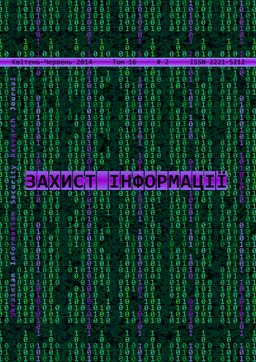Method of image reconstruction based on two-level decoding of linear transforms
DOI:
https://doi.org/10.18372/2410-7840.16.6931Keywords:
image reconstruction, codegram installations, tuple vector decodingAbstract
This paper deals with the main stages of developing the method of image segment reconstruction on the basis of decoding oftruncated double tuple vectors. It has been proved that the method must include the following distinctive stages: installation of codedesign; decoding of code values of the component of double tuple truncated vectors; reconstruction of double tuples based on decodingthe biadic numbers. Installation process, which includes the following actions, is created: selection of an auxiliary part;decomposition of an information part of code design, namely determination of: number of code words; last codegram of non-uniformlength; withdrawal of code words.References
Olifer V.G., Olifer N.A. (2006) Computer Networks. Principles, Technologies, Protocols: College textbook, St.P.: Piter, 958 p.
Gonzales R.C., Woods R.E. (2002) Digital image processing, Prentice Inc. Upper Saddle River, New Jersey, 779 p.
Barannik V., Polyakov V. (2010) Encoding of transformed images within information and communication systems, Kh.: KAFU, 212 p.
Barannik V., Stasev Yu., Turenko S. (2013) Justification of problematic deficiencies of the technology of component coding of transformed images for telecommunication facilities, Modern special equipment, №4, pp. 17-26.
Barannik V., Turenko S. (2013) Combinatorial model of double tuple vector for the assessment of informative value of truncated linear transform, ACS and automatic control equipment, No.163, pp. 17-26.
Barannik V., Turenko S. (2013) Method of verification of tuple vector codec in the keyframe compression system in the information communications
Downloads
Published
Issue
Section
License
Authors who publish with this journal agree to the following terms:- Authors retain copyright and grant the journal right of first publication with the work simultaneously licensed under a Creative Commons Attribution License that allows others to share the work with an acknowledgement of the work's authorship and initial publication in this journal.
- Authors are able to enter into separate, additional contractual arrangements for the non-exclusive distribution of the journal's published version of the work (e.g., post it to an institutional repository or publish it in a book), with an acknowledgement of its initial publication in this journal.
- Authors are permitted and encouraged to post their work online (e.g., in institutional repositories or on their website) prior to and during the submission process, as it can lead to productive exchanges, as well as earlier and greater citation of published work (See The Effect of Open Access).

